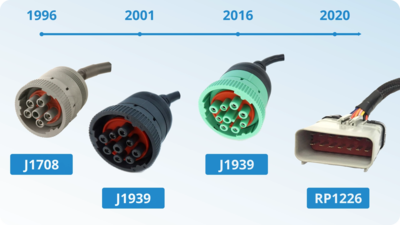
Recently, during an on-site customer installation, I encountered a palpable tension emanating from several drivers, perturbed by the new dash cameras they'd received from us. I initially suspected a malfunction in the units, but the actual issue was more nuanced. The drivers were disgruntled, not due to the technology, but because management had neglected to inform them about the new cameras.
As I explained the advantages of these innovative, AI-powered cameras, which boast a comprehensive 360-degree, four-camera view, I was reminded of the A.D.K.A.R. method, eloquently discussed by Jonathan Shaver from Envision Partners this episode in our podcast. In this blog, we will dissect the ADKAR model and explore how fleet managers can adeptly navigate through technological implementations, mitigating panic and averting potential driver resignations.
What does ADKAR mean
ADKAR, a potent framework devised by Jeff Hiatt, the founder of Prosci, has become an instrumental guide for fleet managers in successfully integrating safety technology, like dash cameras, within their teams of truck drivers.
The acronym ADKAR represents
- Awareness
- Desire
- Knowledge
- Ability
- Reinforcement
Each of which serves as a pivotal step in ensuring the seamless transition and adoption of new technology within a fleet. Originating from Hiatt's experiences with personal change in the late 1990s, the ADKAR model has evolved to become a beacon in organizational change management, providing a structured approach to transition individuals, teams, and organizations from their current state to a desired future state. In the context of fleet management, it offers a systematic pathway to introduce technological advancements, ensuring that every driver is not only aware and desirous of the change but also possesses the knowledge and ability to utilize the new technology, all while being continuously supported through reinforcement strategies.
Technology is a tool
Often perceived as a daunting force, technology, especially when introduced into fleet operations, can stir apprehension among drivers. However, it’s pivotal to underscore that technology acts merely as a tool, one that can significantly amplify the safety and efficiency of fleet operations. Fleet managers, rather than interpreting technology as a potential threat, should embrace it as a strategic ally in enhancing truck driver safety. Optimal fleet technology, such as AI-enhanced dash cameras, grants fleet managers access to invaluable data, enabling them to pinpoint risky driving behaviors, bolster accident prevention, and curtail insurance costs. Find out more about our camera here. These technologies are engineered to coexist with drivers harmoniously, supplying them with instantaneous feedback and coaching opportunities to refine their skills and assure adherence to FMCSA regulations. By recognizing technology as a tool and effectively conveying this to drivers, fleet managers can alleviate their apprehensions, demonstrating how technology can be a boon to their safety and overall performance. This perceptual shift can cultivate a positive disposition towards fleet technology, diminishing the probability of panic or a mass departure of drivers. In essence, technology should be acknowledged as a tool that can enhance the safety and efficiency of fleet operations. By accentuating the advantages of fleet technology and addressing drivers’ concerns, fleet managers can nurture a positive perspective toward these advancements, ensuring a seamless transition and adoption of safety technology within the fleet.
Awareness
Initiating a dialogue about the introduction of new safety technology, such as AI dash cams, is a journey that fleet managers should embark upon not at the installation phase, but from the very moment it becomes a consideration. The essence of this approach is steeped in proactivity: engaging in conversations about potential technological enhancements at the earliest ensures that drivers are not only part of the decision-making process but also have ample time to understand and adapt to forthcoming changes, thereby reducing potential friction during the actual rollout. This early communication ensures that the introduction of the technology is not a surprise but a well-understood enhancement, where drivers are fully aware of its benefits and have had their concerns addressed in advance. They must comprehend the rationale behind implementing such technologies and perceive the tangible benefits they can reap in their daily operations. Begin by articulating the myriad advantages offered by the technology, such as how dash cameras can bolster accident prevention, mitigate insurance costs, and furnish invaluable coaching opportunities, ensuring to underscore how these benefits directly correlate with enhanced driver safety and performance. Concurrently, it's vital to address any apprehensions or objections your drivers may harbor, adopting a transparent stance and fostering an environment conducive to open dialogue, demonstrating that their perspectives are valued and will be considered in the decision-making trajectory. Employing a diverse array of communication channels, such as emails, group meetings, or online platforms, to disseminate information about the new safety technology ensures that your messaging is lucid and succinct, with an emphasis on how the technology is designed to augment, not replace, their roles. Sharing success stories and case studies from fleets that have triumphantly implemented safety technology can illuminate the value and potential impact it can have on their safety, ensuring drivers are acutely aware of the significance and value of this technology in augmenting their safety on the road.
Desire
Instilling a desire among drivers to welcome new safety technology, such as AI dash cams, necessitates a thoughtful approach that addresses their concerns while illuminating the potential benefits. Drivers may harbor reservations, perceiving the technology as potentially intrusive or punitive. Thus, dedicating time to listen to their concerns and providing insightful responses is paramount to dispelling fears and nurturing a positive disposition towards the technology. A viable strategy involves elucidating how dash cameras can augment their safety and serve as a shield in accident scenarios. No seriously, I almost crashed yesterday driving my personal vehicle and my dash cam was unplugged, so It’s absolutely crucial to emphasize that the footage from the cameras can act as impartial evidence, potentially safeguarding drivers from unwarranted claims and mitigating their liability. Moreover, spotlight the coaching opportunities afforded by dash cameras as a means to enhance their driving skills, thereby fortifying their job security. Additionally, sharing success stories from drivers who have seamlessly integrated the technology can be impactful. Allowing your drivers to hear firsthand accounts of how dash cameras have bolstered safety, minimized accidents, and even facilitated recognition and rewards within their fleet can spark a desire to experience these benefits personally. In essence, by meticulously addressing concerns, underscoring benefits, and sharing success narratives, you can kindle a desire among your drivers to embrace safety technology like AI dash cams. Establishing trust and illustrating the positive repercussions on their safety and job security will motivate drivers to integrate this technology into their daily operations willingly.
The Do-It-All Fleet Management Platform.
Start Today, No Contract. No CC.
Knowledge
Empowering your drivers with knowledge becomes a linchpin when introducing new safety technology, such as AI dash cams, into your fleet. Ensuring that drivers are not only well-versed but also confident and proficient in leveraging the technology is pivotal. Begin by orchestrating comprehensive training sessions that delve into the nuances of utilizing the safety technology. This should encompass a spectrum of aspects, from the installation and optimal positioning of the dashcam to the methodologies for accessing, reviewing footage, and deciphering the data amassed. Provisioning a variety of training modalities, including in-person sessions and digital modules, caters to diverse learning preferences and schedules, ensuring accessibility for all drivers. Beyond the initial training, the provision of ongoing support and resources becomes indispensable for drivers to adeptly navigate any ensuing challenges. This might entail reaching out to technical support, additional training sessions, or curating a knowledge base where drivers can seek answers to commonly posed questions. Encouraging drivers to proactively ask questions and provide feedback not only fortifies their understanding of the technology but also garners invaluable insights that can be harnessed to enhance and optimize its application. Consistently communicating updates and proffering tips on effective utilization of the technology ensures drivers remain informed and empowered. By arming your drivers with the requisite knowledge, you pave the way for success in adopting and deriving benefits from the safety technology, culminating in enhanced truck driver safety and an uplift in overall fleet performance.
Ability
Ensuring your drivers possess the ability to adeptly navigate new safety technology, such as AI dash cams, is pivotal in the change management process. This extends beyond mere technological proficiency, encompassing a comprehensive understanding and capability to effectively operate within a technologically enhanced environment. Begin by orchestrating thorough training sessions that delve into the practicalities of the safety technology, ensuring drivers are not only technologically proficient but also understand the broader implications and applications of the technology in their daily operations. This training should traverse through various topics, from the mechanics of mounting and positioning the dashcam to the methodologies for accessing and interpreting footage and data. Hands-on practice and simulation exercises can be particularly instrumental in bolstering drivers’ confidence and proficiency with the technology. Beyond the preliminary training, continuous support and coaching emerge as vital components to enable drivers to maximize the utility of the safety technology. Facilitate regular check-ins and personalized coaching sessions to address any challenges or queries they may encounter. Supply them with resources, such as user manuals and video tutorials, for convenient reference when necessary. Additionally, contemplate instituting a system whereby drivers can share tips and best practices amongst themselves, fostering a collaborative milieu where they can glean from each other’s experiences. By furnishing your drivers with the essential skills and resources, you empower them to effectively wield the safety technology, thereby not only amplifying their safety but also enhancing overall fleet performance.
Reinforcement
Ensuring the enduring adoption of safety technology within your fleet necessitates strategic reinforcement. This pivotal stage involves acknowledging and rewarding drivers for their diligent efforts and accomplishments in assimilating the new technology. Through the reinforcement of positive behavior, fleet managers can cultivate a culture that prioritizes safety and compliance. One method to underscore the utilization of safety technology is by inaugurating a recognition program, which might encompass accolades for drivers who consistently adhere to safe driving practices and proficiently utilize the technology. Celebrating their efforts through awards, incentives, or public acknowledgment can inspire other drivers to integrate the technology and aspire for analogous achievements. Moreover, furnishing ongoing feedback and coaching is indispensable for reinforcing the application of safety technology. Periodic reviews of dashcam footage and the provision of constructive feedback can assist drivers in refining their skills and addressing potential areas of concern. Offering coaching sessions, tailored to individual driver needs, can further amplify their capability to effectively employ the technology. It’s also imperative to perpetually communicate the positive impact of safety technology on the fleet. Disseminate success stories and case studies illustrating how the technology has been instrumental in preventing accidents and enhancing driver safety, serving as a tangible reinforcement for drivers and illuminating the real-world benefits, thereby motivating them to persist in utilizing the technology. Through the consistent reinforcement of positive behavior, acknowledgment of achievements, provision of ongoing feedback and coaching, and dissemination of success stories, fleet managers can engender a culture that ardently supports and embraces safety technology. This not only assures a seamless transition and adoption of the technology but also nurtures a safer and more efficient fleet in its entirety.
Be the hero, not the villain!
The journey of integrating new safety technology, such as AI dash cams, into your fleet is a multifaceted endeavor that extends beyond mere implementation. The ADKAR model – Awareness, Desire, Knowledge, Ability, and Reinforcement – provides a structured pathway to navigate through the complexities of this transition, ensuring that each stage is meticulously addressed to facilitate a smooth and successful adoption. By fostering a transparent and inclusive environment, where drivers are informed, involved, and supported throughout the process, fleet managers can mitigate resistance and enhance the efficacy of the technology integration. The ultimate goal is to cultivate a culture that not only embraces but champions safety and technological advancements, thereby safeguarding the welfare of the drivers and bolstering the overall performance and efficiency of the fleet. As we navigate through the evolving landscape of the trucking industry, let us harness the power of technology, not as a substitute but as a robust ally, ensuring safety, compliance, and excellence in our fleet operations.
Recent Blogs
by Elyse Byers
July 5, 2024




